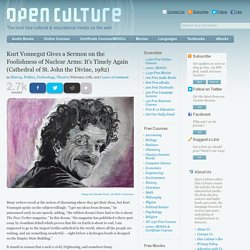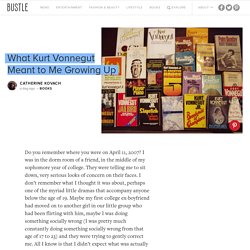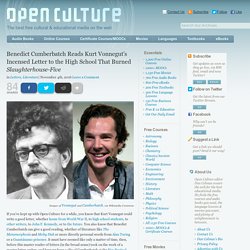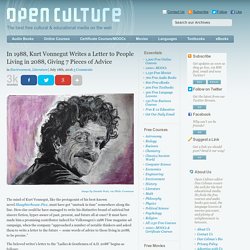

7 Ways Kurt Vonnegut Poisoned Readers’ Minds with Humanity. Kurt Vonnegut once said he wanted his novels to “catch people before they become generals and Senators and Presidents,” to “poison their minds with humanity.

Encourage them to make a better world.” Here are seven ways he lived up to those aspirations. The ‘Moral Clarity’ of ‘Slaughterhouse-Five’ at 50. Eu.indystar. TED-Ed - Why should you read Kurt Vonnegut? Kurt Vonnegut’s Unpublished World War II Scrapbook Reveals Origins of ‘Slaughterhouse-Five’ TED-Ed - Why should you read Kurt Vonnegut? The Six Main Stories, As Identified by a Computer - The Atlantic. “My prettiest contribution to my culture,” the writer Kurt Vonnegut mused in his 1981 autobiography Palm Sunday, “was a master’s thesis in anthropology which was rejected by the University of Chicago a long time ago.”

By then, he said, the thesis had long since vanished. (“It was rejected because it was so simple and looked like too much fun,” Vonnegut explained.) But he continued to carry the idea with him for many years after that, and spoke publicly about it more than once. So it Goes: Our 20 Favorite Vonnegut-isms. Today marks the release of And So It Goes: Kurt Vonnegut: A Life, the first official biography of the great American writer and counterculture icon.

Vonnegut is known not only for his writing but also for his strong ideas, witty remarks, and delightful irreverence, both in his novels and in speeches and commentary. To celebrate the occasion of his first biography, whose title itself is quoted from the repeated refrain in Vonnegut classic Slaughterhouse Five, we’ve compiled a list of the twenty best things Kurt Vonnegut has ever said — according to us, at least. Since the choice quotes from his novels and short stories verge on endless, we’ve limited ourselves to declarations made in nonfiction essays, interviews, and speeches.
Click through to read some hilarious, deep, and snarky missives from one of the greatest writers of all time, and let us know if we’ve missed any of your favorite quotables in the comments. “I apologize because of the terrible mess the planet is in. “Listen. Professors write Salo University blog to celebrate Kurt Vonnegut. Kurt Vonnegut, witty 20th-century science fiction writer and native-born Hoosier, once wrote of a place of learning that existed beyond the boundaries of classrooms, lectures, professors and buildings.

“A kind of university — only nobody goes to it,” Vonnegut wrote in "The Sirens of Titan. " “There aren't any buildings, isn't any faculty. Everybody's in it and nobody's in it. It's like a cloud that everybody has given a little puff of mist to, and then the cloud does all the heavy thinking for everybody.” Contrariwise: Literary Tattoos.
This belongs to Emily T.

The font was somewhat custom, a mix of two or three Microsoft Word fonts.I’ve read Slaughterhouse-Five countless times over the last few years; it always reads a different way. Kurt Vonnegut’s Graduation Speech: What the “Ghost Dance” of the Native Americans and the French… Kurt Vonnegut interview (1999) Kurt Vonnegut, The Art of Fiction No. 64. Kurt Vonnegut Gives a Sermon on the Foolishness of Nuclear Arms: It's Timely Again (Cathedral of St. John the Divine, 1982) Image by Daniele Prati, via Flickr Commons Many writers recoil at the notion of discussing where they get their ideas, but Kurt Vonnegut spoke on the subject willingly.

“I get my ideas from dreams,” he announced early in one speech, adding, “the wildest dream I have had so far is about The New Yorker magazine.” In this dream, “the magazine has published a three-part essay by Jonathan Schell which proves that life on Earth is about to end. I am supposed to go to the largest Gothic cathedral in the world, where all the people are waiting, and say something wonderful — right before a hydrogen bomb is dropped on the Empire State Building.”
What Kurt Vonnegut Meant to Me Growing Up. Do you remember where you were on April 11, 2007?

I was in the dorm room of a friend, in the middle of my sophomore year of college. They were telling me to sit down, very serious looks of concern on their faces. I don’t remember what I thought it was about, perhaps one of the myriad little dramas that accompany anyone below the age of 19. Maybe my first college ex-boyfriend had moved on to another girl in our little group who had been flirting with him, maybe I was doing something socially wrong (I was pretty much constantly doing something socially wrong from that age of 17 to 23) and they were trying to gently correct me.
All I know is that I didn’t expect what was actually wrong. Kurt Vonnegut on the Shapes of Stories. 10 Timeless Quotes from Kurt Vonnegut - For Reading Addicts. The Lasting Charm of Kurt Vonnegut on New Generations of Readers. Kurt Vonnegut’s humor, honesty, and fresh ways of seeing things have always made him a favorite of young people.

I remember back in the late sixties, before Slaughterhouse Five made him rich and famous, college students were carrying around dog-eared copies of Cat’s Cradle, a novel in which he playfully invents a fictitious new religion, foresees a way the world could end, and introduces new words that strike a chord of satiric truth (a “Granfalloon” is a proud and meaningless association of people; examples cited are The Communist Party, The Daughters of the American Revolution, and General Electric.) Buy The Book Few writers are able — or willing — to take on the most serious issues (e.g. the end of the world) and write about them with humor as well as insight.
Benedict Cumberbatch Reads Kurt Vonnegut's Incensed Letter to the High School That Burned Slaughterhouse-Five. Images of Vonnegut and Cumberbatch, via Wikimedia Commons If you’ve kept up with Open Culture for a while, you know that Kurt Vonnegut could write a good letter, whether home from World War II, to high school students, to other writers, to John F.

Kennedy, or to the future. You also know that Benedict Cumberbatch can give a good reading, whether of literature like The Metamorphosis and Moby Dick or more directly personal words from Alan Turing or a Guantánamo prisoner. In 1988, Kurt Vonnegut Writes a Letter to People Living in 2088, Giving 7 Pieces of Advice. Image by Daniele Prati, via Flickr Commons The mind of Kurt Vonnegut, like the protagonist of his best-known novel Slaughterhouse-Five, must have got “unstuck in time” somewhere along the line.

How else could he have managed to write his distinctive brand of satirical but sincere fiction, hyper-aware of past, present, and future all at once? It must have made him a promising contributor indeed for Volkswagen’s 1988 Time magazine ad campaign, when the company “approached a number of notable thinkers and asked them to write a letter to the future — some words of advice to those living in 2088, to be precise.” The beloved writer’s letter to the “Ladies & Gentlemen of A.D. 2088” begins as follows: It has been suggested that you might welcome words of wisdom from the past, and that several of us in the twentieth century should send you some. Volkswagen had asked him to look one hundred years into the future. Data Mining Novels Reveals the Six Basic Emotional Arcs of Storytelling. Back in 1995, Kurt Vonnegut gave a lecture in which he described his theory about the shapes of stories.
In the process, he plotted several examples on a blackboard. “There is no reason why the simple shapes of stories can’t be fed into computers,” he said. “They are beautiful shapes.” The video is available on YouTube. Vonnegut was representing in graphical form an idea that writers have explored for centuries—that stories follow emotional arcs, that these arcs can have different shapes, and that some shapes are better suited to storytelling than others. Vonnegut mapped out several arcs in his lecture. Vonnegut is not alone in attempting to categorize stories into types, although he was probably the first to do it in graphical form. 15 Things Kurt Vonnegut Said Better Than Anyone Else Ever Has Or Will · Inventory. 1. "I urge you to please notice when you are happy, and exclaim or murmur or think at some point, 'If this isn't nice, I don't know what is.'"The actual advice here is technically a quote from Kurt Vonnegut's "good uncle" Alex, but Vonnegut was nice enough to pass it on at speeches and in A Man Without A Country.
Though he was sometimes derided as too gloomy and cynical, Vonnegut's most resonant messages have always been hopeful in the face of almost-certain doom. And his best advice seems almost ridiculously simple: Give your own happiness a bit of brainspace. 2. 3. 4. 5. 6. 7. 8. 9. 10. 11. 12. 64, Kurt Vonnegut. Kurt Vonnegut, ca. 1972. Photograph by PBS This interview with Kurt Vonnegut was originally a composite of four interviews done with the author over the past decade. The composite has gone through an extensive working over by the subject himself, who looks upon his own spoken words on the page with considerable misgivings . . . indeed, what follows can be considered an interview conducted with himself, by himself.
The introduction to the first of the incorporated interviews (done in West Barnstable, Massachusetts, when Vonnegut was forty-four) reads: “He is a veteran and a family man, large-boned, loose-jointed, at ease. He camps in an armchair in a shaggy tweed jacket, Cambridge gray flannels, a blue Brooks Brothers shirt, slouched down, his hands stuffed into his pockets. The last of the interviews that made up the composite was conducted during the summer of 1976, years after the first. You are a veteran of the Second World War? Yes. Why? Which is—? You don’t feel that you have that now? An Ode to Shakespeare from Kurt Vonnegut. After years of double toil and trouble as a public relations man for General Electric, Kurt Vonnegut Jr. sold a story to Collier’s for $750 with a good chance that a couple more would follow suit. Vonnegut: The secret ingredient in my books is, there has never been a villain.
A Teacher Asked Her Students To Write To An Author. Kurt Vonnegut Wrote Back This. Kurt Vonnegut interview in 2005 "Im a man without a country" - one of last before 2007 death. Video: Kurt Vonnegut Artwork Finds New Home at Veterans Museum.